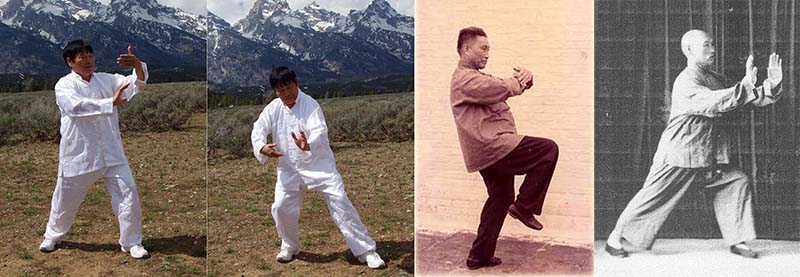
The Progressive Forms of Fu Style Tai Chi – Grasp Bird’s Tail
By Tommy Kirchhoff
Translation by Gordon Yung
Most experts believe there are only five major styles of Tai Chi Chuan, which are derived from five families: Chen (陳), Yang (楊), Sun (孫), Wu (吳) and Wu/Hao (武/郝). These critics proudly purport that all the rest are just lesser sub-sets of the big five.
It is much less known but still a fact that around 1928 the Chinese Central Government named Fu Zhen Song (傅振嵩) as the chief instructor of BaGuaZhang (八卦掌) for the entire nation of China. Fu originally learned Chen Style (陳式) Tai Chi from Chen YenShi (陳延熙), the lineage holder of that epoch and the father of Chen FaKe (陳發科); Fu learned BaGuaZhang from most of the inside students of Dong HaiChuan (董海川). Fu traveled the country and exchanged martial information with many of the best practitioners, and eventually became very close friends with both Yang ChengFu (楊澄甫) and Sun LuTang (孫祿堂).

Front row, left to right: Fu ZhongWen, Yang ChengFu, Fu ZhenSong. In the back row over Yang’s left shoulder is Fu WingFay.
Fu Zhen Song and Sun LuTang were both grandmasters of the Wudang Fists (武當拳): Tai Chi, BaGuaZhang, Hsing-I Chuan (形意拳), and Wudang Sword (武當劍). Both were great innovators of these arts, as well as superb teachers. Fu and Sun each combined elements from BaGua and Hsing-I into their respective Tai Chi styles, and they enjoyed collaborating ideas, techniques and methodologies with one another. Even now in 2019 many Sun Style (孫式) practitioners teach Fu Style (傅式), and vice-versa.
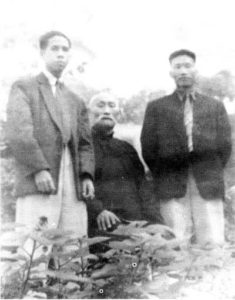
Lin ChaoZhen, Fu ZhenSong, and Fu WingFay.
It is said that the name “internal martial arts” has several meanings, but Neijia (internal arts, 內家) comes first from inside families. Fu ZhenSong’s martial heir was his first-born son, Fu WingFay (傅永輝). Although Fu ZhenSong was one of the greatest innovators of the Wudang arts, his son Fu WingFay grew up learning from many of the greatest grandmasters in addition to studying under his father for 40 years. Fu WingFay was also an innovator and a great teacher. Fu ZhenSong did not appreciate many of the changes Fu WingFay made to the Fu Style Wudang Fist system; but Fu WingFay earned the inheritance of the Fu Style system, so it became his to modify.

Fu WingFay
Fu WingFay’s first major change to the system was developing “Waist Skills.” He integrated bending forward, backward and sideways to step, move, slip and to control one’s self and his or her opponent. He also made the system much softer by eliminating iron body training, and also by developing a recoiling fajin (power emission, fājìn, 發勁). He worked for many years to develop a system of teaching with clear levels for beginner, intermediate and advanced study. He changed some of the postures so they made more sense for applications, and smoothed out many details and fine skills. He also omitted some of the old forms, such as the myriad of Fu Style BaGua spear forms.
To get an idea of the excellence of Fu WingFay’s tutelage look no further than his student Grandmaster Bow Sim Mark (麥寶嬋) and her illustriously famous movie-star son, Donnie Yen (甄子丹).
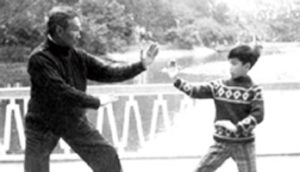
Fu WingFay and Donnie Yen
The second generation of Fu Style also procreated an inside-family martial heir for the third generation. Fu WingFay had eight children, but only Victor Fu (Fu ShengLong, 傅勝龍) would become the martial-arts careerist who inherited the lineage. Victor Fu was immersed in the Fu Style Wudang Fist, and trained under his father for almost 40 years. So, too, did Victor Fu learn to innovate and develop the state of the arts, and teach them to many interested students.
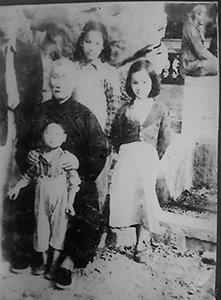
Fu ZhenSong with young Victor Fu
Pull back (lǚ, 捋) is an inward pulling with both hands. Press (jǐ, 擠) is an outward expansion of structure using one horizontal arm with the other hand pushing the back of the wrist. Push (àn, 按) is a rolling, downward push with both hands. Directionally speaking Grasp Bird’s Tail is: up, in, out, and down.
But Fu Style teaches a fifth movement in Grasp Bird’s Tail that is present in other styles but perhaps goes unlabelled. Roll back is the movement between press and push (Grandmaster Victor Fu says the most representative character is 分, or separate). In Fu Style, roll back goes up with both wrists, out laterally, and then down with the palms facing each other.
 Victor Fu, Ward off, photo by Vincent Wong
Victor Fu, Ward off, photo by Vincent Wong

Victor Fu, Flick transition between ward off and pull back, photo by Vincent Wong

Victor Fu, Pull back, photo by Vincent Wong

Victor Fu, Press, photo by Vincent Wong

Victor Fu, Roll back, photo by Vincent Wong

Victor Fu, Push, photo by Vincent Wong
The Fu Style Tai Chi 105-Form teaches several variations of Grasp Bird’s Tail. As the 105-Form essentially follows the same sequence as the Yang Style 108-Form, GBT is one of the first postures. Whereas other family styles teach a simple palm change between ward off and pull back, Fu Style teaches a quick “flick” palm change with an upward-facing palm. Whereas ward off is meant to intercept and lift up an opponent’s arm, the hand flicks underneath, around and onto the top of the opponent’s arm to set up the pull back.

Victor Fu, Waggle transition after push, photo by Vincent Wong
After the push, Fu Style teaches a “waggle” transition. With the fingers pointing up, the
waggle is a small, defensive circle with both hands. If performing Grasp Bird’s Tail –
right, the waggle circles clockwise starting at six o’clock, up to twelve o’clock, and then
back to six o’clock.

Victor Fu, Embrace tiger return to mountain, brush knee, photo by Vincent Wong
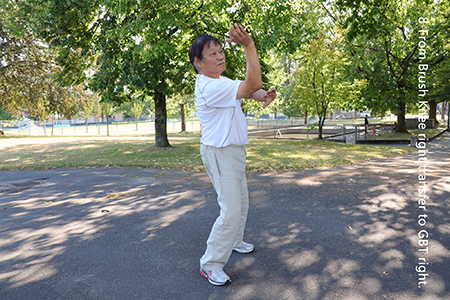
Victor Fu, Insert transition between brush knee and ward off, photo by Vincent Wong
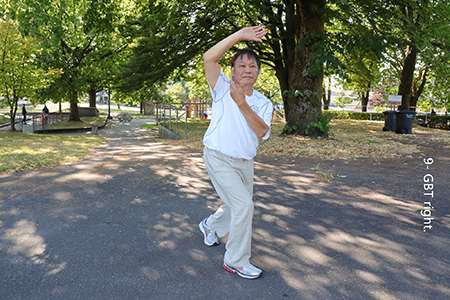
Victor Fu, High ward off, photo by Vincent Wong
The first section of the Fu Style 105-Form is short. After crossing the hands in front, the first movement of the second section is Embrace Tiger, Return to Mountain (bao hu gui
shan, 抱虎歸山). This movement starts with Brush Knee – right (you lou xi ao bu, 右摟膝拗步); then the torso turns left and the left arm draws back. The right hand moves across and “inserts” by raising up until the right elbow meets the left fingers. The torso then turns right and the right arm moves into high ward off. This time the ward off does not stop at chest height, but continues to lift until the right wrist is above the forehead.
The high ward off finishes by turning the palm out. From this posture the player continues through the normal course of GBT including the waggle after the push.
In the third section of the 105-Form, another variation of Grasp Bird’s Tail – right has the
player press and roll back; but at the end of roll back the player turns the toes of the
right foot out 90 degrees (bai bu, 擺步), then steps through and forward with the left
foot. In essence, the push occurs several feet forward of a normal GBT push.
In the next 105-Form variation, the player turns the toes of the left foot out 90 degrees
but instead of stepping forward he or she steps only to the turned-out left
foot. Simultaneous to a high ward off with the right arm the player steps back with the
left foot. Like the variation just mentioned, this variation essentially has the pull back
occur several feet back from a normal GBT pull back.
Fu Style LiangYi Chuan (Harmonized Opposites Boxing, 兩儀拳) is a higher-level and more demanding form than the Tai Chi 105-Form. While LiangYi contains many elements and postures from Tai Chi, it also amalgamates BaGuaZhang changes, stepping and striking. Many of the movements are unique to the form and are not found elsewhere in the system.
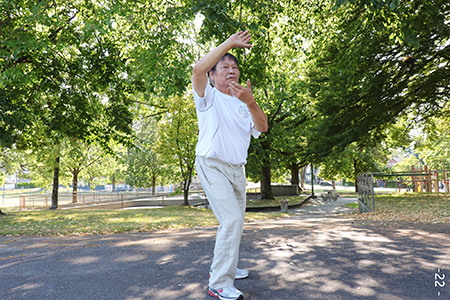
Victor Fu, LiangYi high ward off, photo by Vincent Wong

Victor Fu, LiangYi short pull back, photo by Vincent Wong
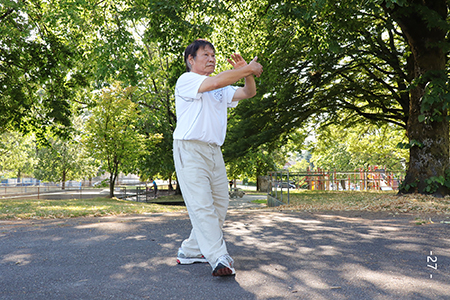
Victor Fu, LiangYi press with bai bu, photo by Vincent Wong
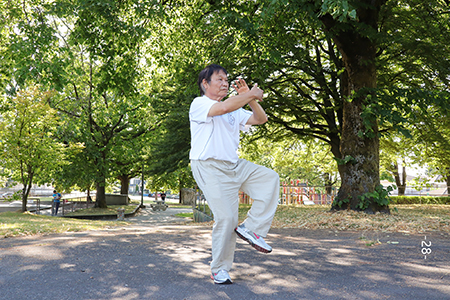
Victor Fu, Liangyi press with weight shift, photo by Vincent Wong
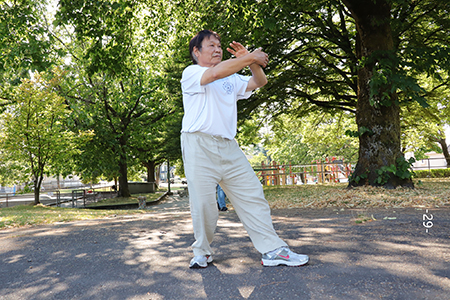
Victor Fu, LiangYi press with BaGua step, photo by Vincent Wong
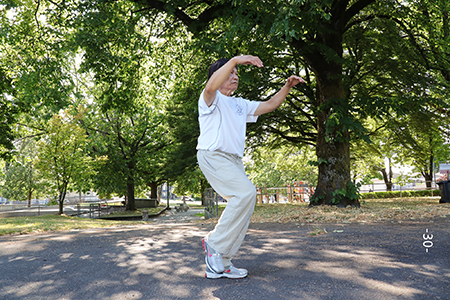
Victor Fu, LiangYi roll back with knee lift, photo by Vincent Wong
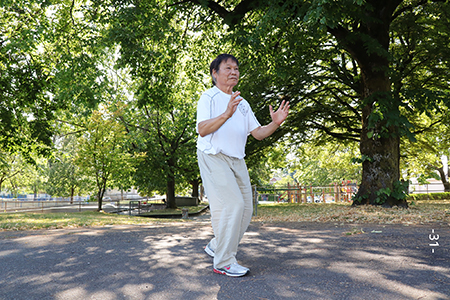
Victor Fu, LiangYi roll back with capture, photo by Vincent Wong
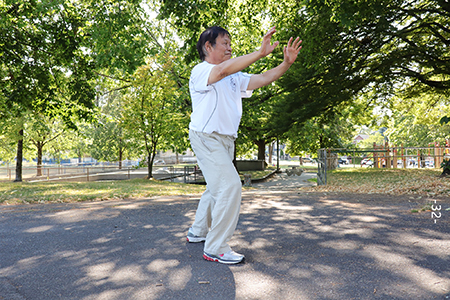
Victor Fu, LiangYi roll back with capture, photo by Vincent Wong
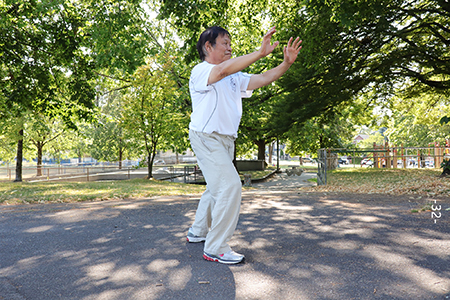
Victor Fu, LiangYi push with feet separation, photo by Vincent Wong
LiangYi’s Grasp Bird’s Tail – right occurs twice within the 81-movement sequence. The first begins with a fast, high ward off and an exaggerated twist of the trunk to the right. The pull back is shorter, followed by an immediate bai bu of the right foot. The player shifts quickly forward onto the right foot, and performs press with a brisk, long, BaGuaZhang step forward with the left foot. The press finishes with a snappy slide-off of the left hand, and a full shifting of weight onto the left foot. The roll back uses the same upward lifting of the wrists as before (it’s more of a “roll up” than a roll back), and raises simultaneous to an offensive high lift of the right knee. The player takes one more fast BaGua step forward with the right foot, bringing the left foot near the right heel. The push has an explosive fajin that drops the body weight quickly while spreading the feet apart. The distance between the point where the right foot started at ward off and where it finishes at the push can be 10 feet or more, which is impressive considering there are only two steps.
The second GBT in LiangYi is the same as the first, but instead of a stationary ward off the player holds the ball – left and spins 360 degrees clockwise on the right foot. Then the player performs a double pull back, first to the right side and then to the left side. After the right-side pull back the player BaGua circle walks counter-clockwise, first with a right foot circle step finishing with the right toes turned in (kou bu, 扣步), then with a left foot-circle step finishing with bai bu. The right foot circle steps again, finishing with kou bu, then the left foot sweeps behind and the player half-spins on the right foot such that both feet finish parallel. The player pulls back – left from this position then launches into the BaGua-step press and the remainder of LiangYi GBT as detailed above.
The Fu Style Tai Chi Lightning Palm (太極閃電掌) form is even higher level than LiangYi. It contains three sections of Tai Chi and one section of BaGuaZhang. The form begins with Grasp Bird’s Tail to the four directions, each finishing with an explosive fajin push.
The Fu Style Yin (陰) Palm BaGuaZhang form includes Grasp Bird’s Tail in several of the Gua (第一卦) subsets. This time it is most similar to the GBTs in 105-Form Tai Chi but it is executed on the circle. It starts from the BaGua guard position with the long arm stretching toward the center of the circle, fingers up, and the fingers of the short arm pointing toward the elbow of the long arm. Both arms move across the body similarly to pull back; this transitions to press, roll back and then a push with fajin. This GBT also finishes with the waggle.
Fu Style has an Advanced Tai Chi (高級太極拳) form that is unique to the martial arts. The player performs Grasp Bird’s Tail to the right and to the left, but the sequence is a mind-blowing departure from peng, lǚ, jǐ, an, as the sub-postures extrapolate and multiply unrecognizably. The player hip-pikes and extends; he or she rolls up and rolls down; the chest opens and closes; and the push finishes with three or more bouncing fajin.
In application these variations on Grasp Bird’s Tail still train the basic energies and directions but provide the player with more options. As the repetition of practice gradually makes the movements occur naturally, the player will also feel his opponent’s pressure or retraction, and be able to adjust farther up or down, forward or backward. The stepping in particular allows the player to change positions easily, and the practice of sinking, shaking and recoiling can develop fajin power to great levels.
Grandmaster Victor Fu continues to teach in Vancouver, British Columbia, and he offers all of his forms as instructional videos on his website, FuStyle.com.
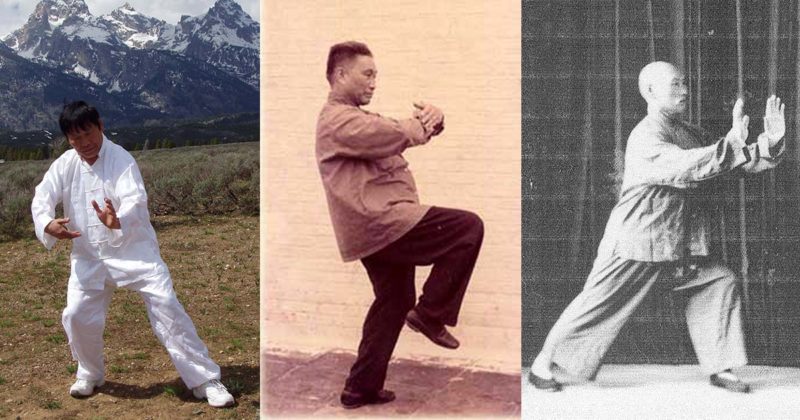
Leave a Reply